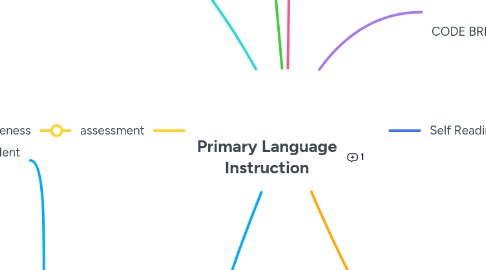
1. All things Text
1.1. Joy of reading
1.1.1. select texts based on student interests
1.1.1.1. picture books
1.1.1.2. graphic novels
1.1.1.3. novels
1.1.1.4. articles
1.1.1.5. videos
1.1.1.6. audio
1.1.1.7. infographs
1.1.1.8. comics
1.1.1.9. documentaries
1.1.2. Select books according to students' reading level so that they do not get bored/overwhelmed
1.1.3. select texts that students can see themselves in.
1.1.3.1. support development
1.1.3.1.1. social
1.1.3.1.2. emotional
1.1.3.1.3. physical
1.1.3.1.4. mental health
1.1.3.1.5. CRRP
1.1.3.2. Student centered reading materialthat that is culturally relevant
1.2. Levelled texts
1.2.1. Challenge students to know more about their potential and motivate students' learning initiatives
2. Instructional Strategies
2.1. Modelled
2.1.1. Read-alouds/ think alouds
2.2. Guided
2.3. Shared
2.3.1. activities to follow: picture sequence, re-telling, role-play/readers theatre, text reconstruction (Effective Reading p. 5.10)
2.3.1.1. Shared writing of intentional sentences to help kids commit high frequency words and new words to memory
2.3.1.2. Guided reading vs shared: Shared text poses more challenges, Shared reading focuses on teaching strategies vs. guided reading focuses on supporting students' application of strategies (Effective Reading p. 6.6).
2.3.1.2.1. Guided reading- in zone of proximal development where students are in flexible groups based on various needs such as fluency, comprehension strategies, text features, etc
2.4. Independent
2.4.1. small books based on interests and educational needs/reading levels
2.4.2. Reading in zone of actual development, where students can read words with 90% accuracy
3. Differentiation
3.1. Short sessions - chunk into 15 min blocks
3.1.1. Move from simple to complex
3.1.1.1. Start with direct and guided instruction and move to provide ample independent reading opportunities
3.1.1.1.1. Predictable and regular schedule
4. ELL students
4.1. bilingual dictionaries, peer tutoring, extra time, graphic organizers, word webs to build vocabulary (Effective Writing, pg 32)
5. assessment
5.1. phonemic awareness
6. Self Reading
7. CODE BREAKER: Decoding Words
7.1. Phonological Awareness
7.1.1. Explicitly teach rhyming words and generate lists of rhyming words (from Effective Early Reading Instruction)
7.1.2. Tap or clap out words in a sentence. Tap or clap syllables in a word.
7.2. Phonemic Awareness
7.2.1. Practice making the sounds of each of the letters in a word. Make new words that have the same beginning or end sounds
7.2.2. words, syllables, graphemes (letters), phonemes, morphemes
7.3. Phonics
7.3.1. Teach letters in order that let you build words quickly (ex. M, S, T, P, A, will let students read more than 20 words with short a sound. (Shifting the Balance)
7.3.1.1. Strategies
7.3.1.1.1. Form letters using multimodalities
7.3.1.1.2. Print letters
7.3.1.1.3. familiar words (ex. names,)
7.3.2. Start with easiest and build from there (ex. teach letters before CVC words, and CVC words before longer words with more complex spelling. (Shifting the Balance)
7.3.3. Be aware of letters and sounds that are easily confused. (ex. M and N, or B and P both look similar and sounds are easy to confuse. They should not be taught together.) (Shifting the Balance)
7.3.3.1. Use simple rhymes/sayings to help children remember the difference between letters (for b and d: the bat before the ball)
7.3.4. Provide children frequent opportunities to apply learning (ex. shared reading, magnetic letters) Shifting the Balance.
8. Fluency
8.1. Accuracy
8.1.1. Naming words effortlessly and using a process to understand unfamiliar words
8.1.1.1. Supported by: phonemic awareness, letter-sound knowledge (alphabet and phonics), sight words, and high frequency words
8.2. Rate
8.2.1. Reading a text with speed and fluidity (while STILL comprehending the text)
8.3. Prosody
8.3.1. Reading with expression
8.3.1.1. Using: intonation, punctuation, and phrasing
9. Instructional Approaches: -read with a whisper phone -read with a puppet -read with a mask -read to a figurine or a stuffed toy -read with a microphone -read to an image of a familiar celebrity -spin/roll and read to listed person (e.g., parent, sibling, teacher, cartoon or media personality)
10. MEANING MAKER: Comprehension:
10.1. activities to make meaning, eg: sketch to sketch, save the last word for me and picture walk (Effective Reading, p. 3.28-3.29)
10.1.1. ways to respond orally: retell, relate, review, reflect (Effective Reading, p. 3.17)
10.1.1.1. Strategies to activate prior knowledge: anticipation guides, mind maps, predictions, picture walks. (Effective Reading)
10.1.1.1.1. strategies during reading to build comprehension: dramatizing, graphic organizers, visualization, directed questions to encourage learners to synthesize and infer (Effective Reading, ch. 8).
10.1.1.1.2. Structured play with letters (ex. tactile alphabet book)
10.1.1.2. Ask students to what they think the book is about based on the title/cover page
10.2. Language Comprehension + decoding ability =Reading comprehension
10.3. Comprehension Strategies
10.3.1. Inferencing
10.3.2. Acitivating prior knowledge
10.3.3. Asking Questions
10.3.3.1. Critique
10.3.4. Synthesizing
10.3.4.1. Analyzing
10.3.5. Determining key ideas
10.4. Teaching Strategies for Comprehension
10.4.1. Scaffolding
10.4.2. Coaching
10.4.3. Reflecting
10.4.4. Guiding
10.4.5. Thinking Aloud/Modelling
10.4.6. Gradual Release of Responsibility
